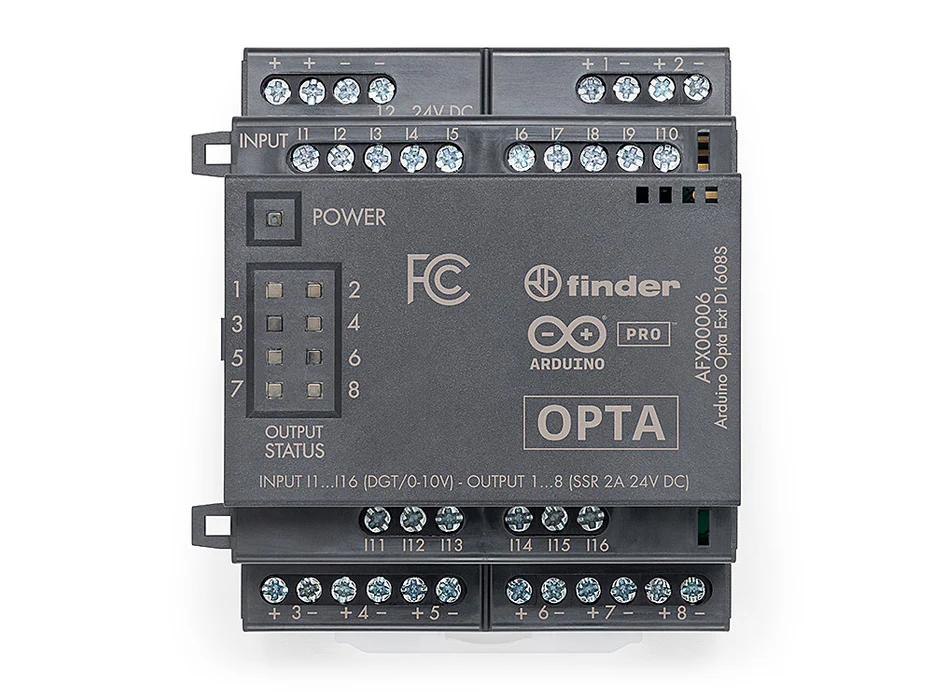
Arduino Pro Opta Ext D1608S
The snap-on expansion module to enhance Arduino Opta’s applications with the addition of 16 programmable voltage inputs and 8 solid-state relays.
Overview
Arduino Pro Opta Ext D1608S enhances your Arduino Opta’s real-time control, monitoring and predictive maintenance applications with the addition of 16 programmable voltage inputs and 8 solid-state relays 24 VDC 2A.
Just snap on the module to extend your system’s capabilities flexibly and quickly, and manage the new I/Os from the Opta base unit seamlessly, taking advantage of the open and widely known Arduino ecosystem or PLC IDE IEC 61131-3 programming environment.
Key benefits:
- Flexible inputs: 16 new inputs for your applications per each expansion added, programmable as digital 0-24 VDC or analog 0-10 V.
- Powerful outputs: 8 solid-state relays offering 24 VDC for 2A each.
- Up to 5 snap-on modules can be managed to multiply and mix a set of I/Os with seamless detection: snap them right next to your Opta base module and use the I/Os as native Opta resources.
- Extend your hardware capabilities while keeping programming accessible, by using the Arduino IDE with its wide range of ready-to-use sketches, tutorials and libraries.
- Put your new I/Os easily to work with the PLC IDE for IEC 61131-3 PLC languages, taking advantage of its low-code approach and pre-mapped resources.
- Extend the Opta’s benefits of real-time remote monitoring via intuitive Arduino Cloud dashboards and secure communication to a wider set of connected devices.
- Reliable by design, thanks to industrial certifications and Finder’s expertise in electronic devices.
- Easy DIN rail installation.
Applications
Opta’s digital expansions are ideal to increase the number of real-time control points in the manufacturing sector and in any building automation project.
The Opta Ecosystem is compatible with all major cloud providers – but choosing the simplicity of Arduino Cloud can really make a difference, for anyone who wants to build, customize and remotely manage their own dashboards.
Looking for a similar option?
Check out the Arduino Pro Opta Ext D1608E, to add 8 electromechanical relays 250 VAC 6A to your Opta-based solution.
Conformities
Resources for Safety and Products
Manufacturer Information
The production information includes the address and related details of the product manufacturer.
Arduino S.r.l.
Via Andrea Appiani, 25
Monza, MB, IT, 20900
https://www.arduino.cc/
Responsible Person in the EU
An EU-based economic operator who ensures the product's compliance with the required regulations.
Arduino S.r.l.
Via Andrea Appiani, 25
Monza, MB, IT, 20900
Phone: +39 0113157477
Email: support@arduino.cc
Documentation
Learn more
Get Inspired

This project shows how to create a security system using the camera of an Arduino Nicla Vision board. The system automatically triggers a camera snapshot when presence is detected. Presence is detected when the system detects a sound level that exceeds a configurable threshold. The whole system is controlled by an Arduino Cloud dashboard.

Shortly after attending a recent tinyML workshop in Sao Paolo, Brazil, Joao Vitor Freitas da Costa was looking for a way to incorporate some of the technologies and techniques he learned into a useful project. Given that he lives in an area which experiences elevated levels of pickpocketing and automotive theft, he turned his attention to a smart car security system. His solution to a potential break-in or theft of keys revolves around the incorporation of an Arduino Nicla Vision board running a facial recognition model that only allows the vehicle to start if the owner is sitting in the driver’s seat. The beginning of the image detection/processing loop involves grabbing the next image from the board’s camera and sending it to a classification model where it receives one of three labels: none, unknown, or Joao, the driver. Once the driver has been detected for 10 consecutive seconds, the Nicla Vision activates a relay in order to complete the car’s 12V battery circuit, at which point the vehicle can be started normally with the ignition. Through this project, da Costa was able to explore a practical application of vision models at-the-edge to make his friend’s car safer to use. To see how it works in more detail, you can check out the video below and delve into the tinyML workshop he attended here.














